Yet mainstream US media outlets and partisan politics are routinely oblivious to threat of oblivion.
By Norman Solomon, The Nation
The dangers of nuclear war have never been higher, but political pressure to prevent it is at low ebb. Eighty years after the atomic age began with the Trinity bomb test in New Mexico on July 16, 1945, words can’t possibly be adequate to describe the extent of global horrors that today’s nuclear arsenals are capable of inflicting. But mainstream US media outlets and partisan politics are routinely oblivious to the threat of oblivion.
Despite the efforts of individuals and groups striving for arms control, the national discourse ignores the likely results of nuclear buildups—which continue to boost the actual risks of annihilation. Pronouncements from the nuclear establishment about a need to “maintain deterrence” and “modernize” usually go unquestioned as to the underlying assumptions. Senators and representatives praise nuclear systems with components produced in their state or district.
Even well-informed and dedicated advocates of halting the arms race are often reduced to arguing for fiscal responsibility. Within the narrow confines of regular “national security” debates, the wisest lobbying tactic appears to be a focus on exorbitant costs of “modernizing” nuclear weapons. Yet cost-cutting arguments bypass how the weapons push the world closer to doomsday.

Northrop Grumman—the contractor for the new Sentinel ICBM, which is meant to replace the current Minuteman III intercontinental ballistic missiles—has racked up such huge cost overruns that the project at times seemed to be in jeopardy of cancellation. Meanwhile, the political response detoured around the unique dangers of ICBMs, which (as land-based missiles vulnerable to attack) remain on hair-trigger, “use them or lose them” alert. Given the long record of false alarms, such hypervigilance is a possible tripwire for an accidental apocalypse.
“Getting trapped in an argument about the cheapest way to keep ICBMs operational in their silos is ultimately no-win,” Daniel Ellsberg and I wrote for The Nation in autumn 2021. We added: “Better sooner than later, members of Congress will need to face up to the horrendous realities about intercontinental ballistic missiles. They won’t do that unless peace, arms-control, and disarmament groups go far beyond the current limits of congressional discourse—and start emphasizing, on Capitol Hill and at the grassroots, the crucial truth about ICBMs and the imperative of eliminating them all.”
More than 700 scientists signed a letter last summer going beyond the focus on cost to urge the complete elimination of America’s ICBMs. The letter, organized by the Union of Concerned Scientists, explained that “the US could eliminate the land-based leg of the triad tomorrow and the US public would only be safer for it.”
Recent Posts
Utah Leaders Are Hindering Efforts To Develop Solar Despite A Goal To Double The State’s Energy Supply
December 12, 2025
Take Action Now Utah Governor Spencer Cox signed bills that will make it more difficult and expensive to develop and produce solar energy, ending tax…
Report of the Independent Democratic Task Force on U.S. Policy Toward Israel
December 12, 2025
Take Action Now For release in connection with the winter meeting of the Democratic National Committee convening on December 11, 2025 in Los Angeles……
U.S. Realizes It Can Seize Boats After All
December 11, 2025
Take Action Now After months of extrajudicial killings in the waters off Venezuela, the Trump administration opted instead to capture an oil tanker.……
Wrong voters, wrong message: progressives’ autopsy lays bare Kamala Harris failures
December 10, 2025
Take Action Now RootsAction report finds Harris courted moderates instead of working-class Democrats – and Gaza stance did not helpBy David Smith,…




